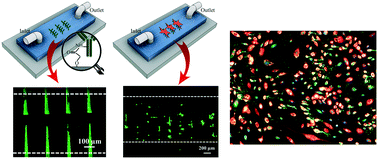Plasma-induced covalent immobilization and patterning of bioactive species in microfluidic devices
Abstract
Here, we present a straightforward technique to create bio-functional microfluidic channels using CO2 plasma to induce both carboxylic and hydroxyl groups onto the channel surface. Consequently, not only does the surface allow for irreversible covalent bonding to an oxygen plasma treated PDMS for microfluidic device fabrication, but it also provides functionality for biomolecular immobilization. Furthermore, we demonstrate integration of this technique with microcontact printing to covalently micropattern functional biomolecules inside microfluidic channels. The bio-functionality and efficacy of the microcontact printed antibodies is demonstrated for both bioassays as well as patterning and culturing different cell lines. Results show that the introduced method can be an excellent candidate for cell culture studies in microfluidics. With the new printing method, full cell confluency (∼400 cells per mm2) was achieved after incubation for only 1 day, which is significantly greater than other conventional cell culture techniques inside microfluidic devices. As a proof of concept, we demonstrated the endothelial cells functionality by stimulating von Willebrand Factor secretion under shear stress. This is done via perfusion of histamine through the channel and performing immunofluorescence labeling to observe the inflammatory response of the cells. The developed method eliminates the need for wet chemistry and significantly simplifies producing bio-functional chips which can be used for biosensing, organs-on-chips and tissue engineering applications.



 Please wait while we load your content...
Please wait while we load your content...